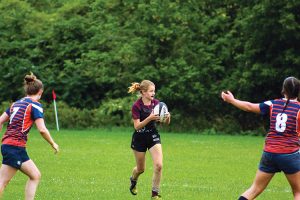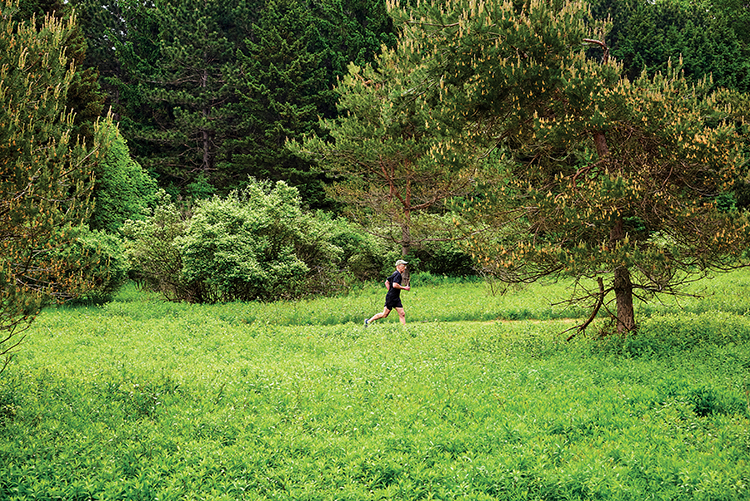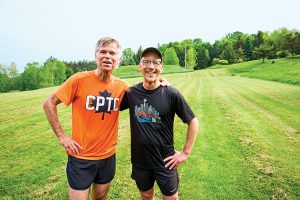Showing Fortitude in the Face of Danger
 Reading “Patient Zero,” I marveled at Hannah’s astonishing courage and resilience, as well as the dedication and selflessness of her family and those who helped save her. There were also tears in my eyes, because the way in which Colgate rallied to her side reminded me of what it did for me, once.
Reading “Patient Zero,” I marveled at Hannah’s astonishing courage and resilience, as well as the dedication and selflessness of her family and those who helped save her. There were also tears in my eyes, because the way in which Colgate rallied to her side reminded me of what it did for me, once.
In January 1993, I returned to Colgate reeling from twin tragedies: the suicide of my mother and the (unrelated) suicide of my close friend and classmate, Bill Moll ’94.
Every step of that awful road, Colgate was there for me, from President Grabois to Dean Linquest to my professors to my friends. Thanks in large part to their love, empathy, and support, I stayed in school, persevered, and graduated with honors. My mother would have been proud. I’ll always be grateful to Colgate for that.
The names were different, but the Colgate spirit remains. Best of luck to Hannah.
H. Seth Resnik ’94
I could not get over reading about what Hannah Tubbergen ’20 went through. What incredible courage, bravery, and persistence. And what an amazing comeback she has made. Also, how the college supported her during her critical period of time — that was wonderful. What an unbelievable experience!
Jennifer (Smith) Linck ’73
I have rarely been so captured by a story. Congrats to the entire University for its planning, preparation, and execution during what could have been a serious medical problem for the entire campus. Well done.
Kevin Sio ’73
I recall a meningitis case in Cutten (now 113 Broad St.) in 1990 or 1991. We all took pills that turned our urine a shocking Day-Glo orange. Spring Party Weekend T-shirts that year were in that color with the saying “the dorm that pees together, stays together.”
This story drives home how very lucky we were.
Erin Read ’92
Hannah is amazing. So glad she made such a remarkable recovery. It must have taken years off her parents’ lives. I think her roommate, Amina Rehman ’20, is the hero of this story.
Liz Armstrong ’81
We thank everyone who played a part in our story. We were embraced by the Colgate community, alumni, prayer warriors, rugby and softball families, sorority sisters, hometown friends, and family.
It was a terrible time, but we were totally blessed by God, and an outpouring of love and support. Thank you to all the medical members who worked on Hannah. We can’t express our gratitude for your caring. We truly appreciate you all.
Debbie Tubbergen
Thoughts on “Nevertheless, She Persisted”
On “Voices”: [Laurie Adami ’81, you] have taken on this cancer challenge just like everything else I have seen you tackle. I am so sorry you and your family have had to go through this. This sounds like a miracle!
Cathy Ehrlich ’82
Incredible story of resilience, hope, tenacity and so much more. Laurie is an inspiration.
Nancy Horwitz ’81
I read the “Voices” column with unease, particularly the title, “Nevertheless, She Persisted.” That phrase came into its current popular usage because of a unique political moment. A woman was doing her job, a colleague disagreed with her approach, and a meme was born. Everything, from the time each registered for a political party, to the episode in the U.S. Senate, was the result of choices those people made. No one registers for cancer. Yes, those who have been diagnosed face choices, beginning with whether or not to seek treatment. But you can’t reason with cancer. You can’t vote cancer out of office. While certain aspects of politics are life or death matters, they are matters we can more fully comprehend. We know what happens when a bomb is dropped, or when a law is passed restricting or enabling a liberty. Equating cancer with politics is unfair. There is far too much out of our control.
Jennifer Sharp ’98
Remembering a Former Student
On “A Lawyer Walks into a Bar and Doesn’t Leave”: I feel honored to have been the adviser for Drew Kostic’s (Class of 2008) thesis on Tibetan Buddhism and its effects on anxiety about death.
Rebecca Shiner, professor of psychological and brain sciences
Another Iconic Professor
On “Class Acts”: And then there was the iconic Professor Bruce Selleck… Get that man going around a campfire on the Geology OC and you knew you were in for some great stories.
Josh Solomon ’14
Reunion Reflections

Peter Ilgenfritz ’84 won the reunion 5K race on the Harry Lang Cross-Country and Fitness Trails.
It’d been 30 years since I’d been to reunion. I have vague recollections of my 5th Reunion — a warm day, a white tent, a brief exchange of “Hey, how ya’ doin’?” … “Good” … “Good” with guys from my dorm. A feeling of uncertainty, a twinge of fear, a shell of self-consciousness.
I tossed out the invitation to the All-Class Reunion, having no intention of attending. But the one Colgate friend whom I hadn’t lost touch with called and said, “You should come,” and for some reason, despite all my endless considerations and good reasons not to, I signed up. Perhaps curious, perhaps “200 years” had some weight of importance, perhaps something I needed to discover.
I drove 3,228.6 miles from Seattle. Stepped out in downtown Hamilton on a warm evening. There were changes. An Indian restaurant and a Vietnamese restaurant — is this Hamilton?
In the past months, I’d wondered if being back here would be a confusing spin of discordant snippets of random memories, a descent into despair at still trying to make sense of my experience here, a shadow of faces and names I no longer recognized.
I headed to registration and picked up a maroon cap with a gold “C.”

Ilgenfritz (right) with John Kenney ’78, who placed second.
Early the next morning, Alumni Hall, rows of white chairs. I looked up as members of my class crowded into the back rows. I was surprised how moved I was that they had taken the time to be here — and at 9 a.m. on a Friday. I’d volunteered to present on “Navigating Change,” a key issue in my life, as in many 50-something-year-olds.
I leaned back against the small desk at the front and opened my tattered copy of a gray book held together with duct tape, as religion professor R.V. Smith had done the fall of my first year in the room next to this one. He read to us, as I read to the class gathered that day, from H. Richard Niebuhr’s Radical Monotheism and Western Culture about the “one thing in life with which we all must reckon,” the “void” that is the “source of all and the end of all … from which there is no escape.” As an 18-year-old, I knew enough of loss to be riveted by Niebuhr’s words and his call to “trust” in this void. Now, at 57, I knew a lot more about what the “void” meant.
After my talk, I stood in line for lunch on Whitnall Field wondering where to sit when I spotted a table with two white-haired couples. Angelo LaDuca ’59, P’91 extended a warm greeting and told me that at my age, he, too, had stepped out from a job of many years, took a plunge into the “void” of not knowing, and discovered a new passion. Thanks to the encouragement of his wife, he’d become an oil painter. He’d organized an alumni art show and invited me to attend the reception later that afternoon.
I recall the scenes of the following days like Angelo’s oil paintings or Tommy Brown’s (Class of ’79) photographs of Madison County, little still lifes, stories in time.
I sit in front of Olin Hall and introduce myself to Tiffany, a 2009 graduate from Jamaica. She tells me about her interest in immunology and her work with people who have HIV. I tell her about my own work running an AIDS organization in the late 1980s in Chicago. She tells me her stories of struggling to find a sense of grounding here at Colgate, so far from home. I share my own.
We go over to join the Alumni of Color Bicentennial tree dedication. Provost and Dean of the Faculty Tracey Hucks ’87, MA’90 waters the tree, blessing it to grow deep roots, as a reminder that we must not forget the powerful legacy of students of color in this place that has struggled with accepting and celebrating their gifts over the past centuries.
Afterward, we walk over to the ALANA Cultural Center 30th Anniversary Celebration. Diane Ciccone ’74, P’10 signs her book, Into the Light: The Early African-American Men of Colgate University Who Transformed a Nation, 1840-1930. I wonder on all that has kept us from celebrating the legacy of these men who went on to become leaders. I realize that learning this history is part of an integration, a healing, that has drawn me back for reunion.
Later that afternoon, I’m struck that I’m no longer apprehensive about going to the LGBTQ and allies reception. Thirty-nine years ago, a gathering like this would have been held in an anonymous site. Today, the reception is hosted by the Vice President and Dean of the College Paul McLoughlin II and his husband at their home.
It was not an easy time at Colgate 1980–1984, perhaps no era is when you are 18–22. It was a community torn as it struggled to make real the welcome it proclaimed for students of color and women. Not a safe place for a young man like me who was questioning his sexuality.
In Chapel House, Professor Steven Kepnes sparks a spirited conversation on “Why God Today?” — the conversation more inclusive of other perspectives than it had been decades before. Yet there’s a similar resonance that runs through the conversation, an appreciation that contemplation and reflection are values still to be celebrated and needed more than ever before. After the conversation, I find myself talking about God with one of the guys whom, decades before, I’d never said anything beyond “Hey, how ya’ doin’?” Life’s changed.
That night, on Whitnall Field, a classmate tells me: “I vaguely remember you. You were introverted, quiet. Don’t take this the wrong way, but what happened?!” I laugh. I’ve grown; we all have.
Early the next morning, I gather with the small crowd on Trainer Hill for the reunion fun run. The long green field above campus was always one of my favorite places to get away and watch the clouds drifting slowly down the valley.
Amber Williams, director of track and field, jokes that she brought her stopwatch, “to set your PR if you want to.” I decided I might as well. It took 39 years for my first and only athletic achievement at Colgate: I won the race.
I may never make sense of my Colgate experience, as I will never figure out my 18-year-old self. But perhaps that was never the point. Instead, to take in the wonder of this present time, to witness how I’ve grown and Colgate as well.
I reunited with a school, a history, that is a work in progress but one worth working at, moving toward wider inclusion, deeper justice for the future generations that will be shaped here, as I have been.
I’ll be back.
Peter Ilgenfritz ’84
Read more on this year’s All-Class Reunion.
Send your letters to Colgate Magazine: magazine@colgate.edu or 13 Oak Drive, Hamilton, NY 13346. We reserve the right to decide whether a letter is acceptable for publication and to edit for accuracy, clarity, and length. Letters deemed potentially libelous or that malign a person or group will not be published. Submissions should not exceed 250 words. Please include your full name, class year, and location.
